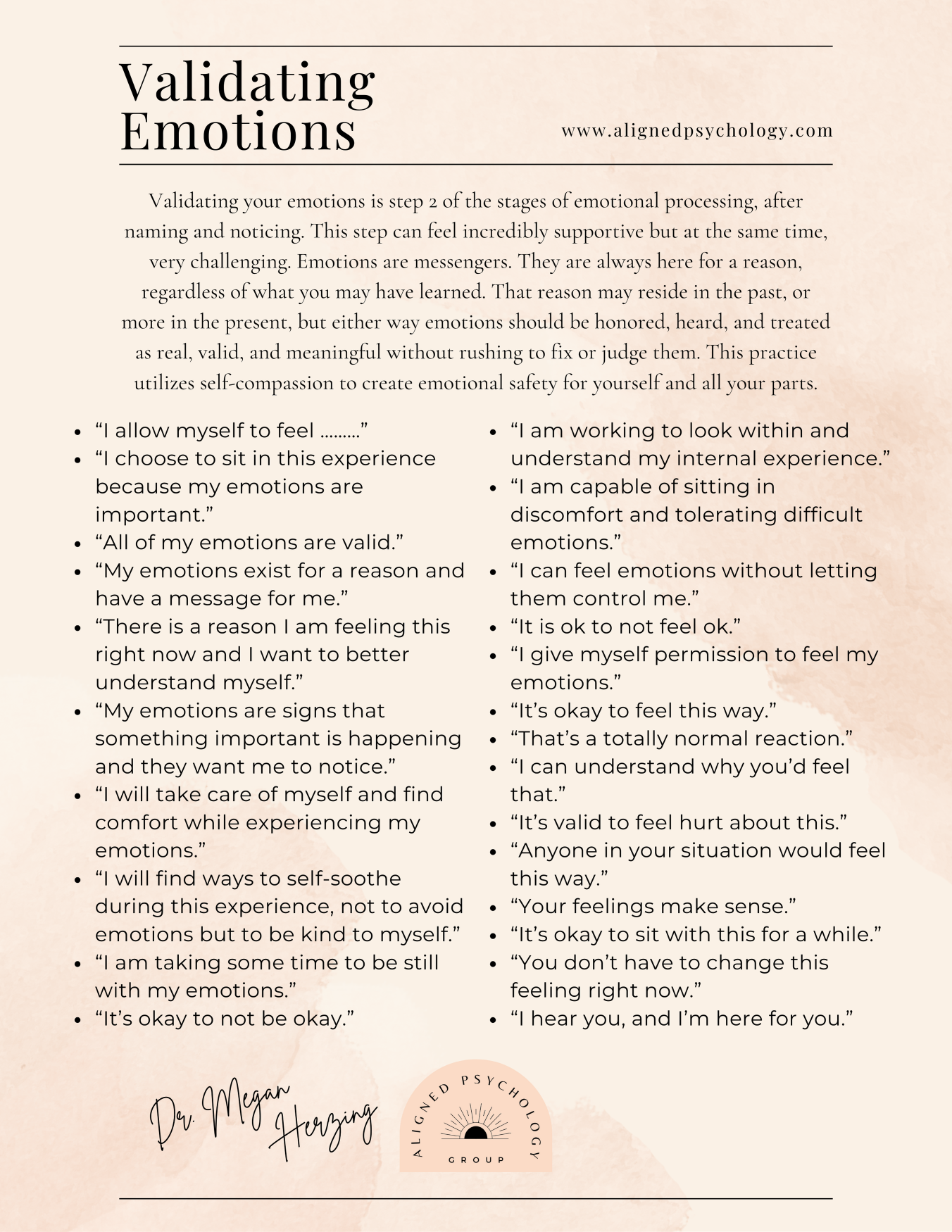Trauma Therapy Homework - Week 6
Week 6: (The Basics)
Validating Emotions
Welcome to another chapter in your trauma therapy homework series! Today, we’re diving into a practice that can feel both deeply nurturing and surprisingly challenging: validating emotions. This isn’t just about saying, “It’s okay to feel sad” (although that’s a good start). It’s about truly acknowledging emotions—yours or someone else’s—as real, valid, and meaningful without rushing to fix or judge them.
This practice builds on our earlier homework of naming and noticing emotions. If you’ve been following along, you’ve already started identifying and labeling what you feel and where you feel it in your body. Now, we’re adding the next layer: validating those emotions as an essential part of your healing journey. If you haven't read the first step of processing emotions, check out Trauma Therapy Homework: Week 1.

Why Validate Emotions?
Emotions are powerful messengers. They carry vital information about our needs, boundaries, and experiences. For example, anger might signal that someone has crossed a line, while sadness might indicate a longing for connection. Even if an emotion feels overwhelming or confusing, it has a reason for being there. Sometimes, it’s tied to something in the present, but other times, it’s like an echo from the past—your brain responding to something that reminds you of an old hurt or experience. That doesn’t make the feeling any less real or important; it just means there’s more to explore. Trying to “logic” your way out of emotions can feel like dismissing a part of yourself. Instead, you can try listening to what the emotion is trying to tell you. When you understand what’s underneath—what need is unmet or what’s being triggered—it becomes easier to care for yourself in a way that feels healing and meaningful. Emotions aren’t “irrational” or “bad.” They’re part of how we navigate the world and make sense of our experiences. You don’t have to fight them; you can work with them, like a guide leading you toward what matters most to you. When we dismiss or ignore our emotions, we miss out on the wisdom they offer. Validating emotions means saying, “I hear you. I see you. You make sense. I am listening. I know you are here for a reason.”
Trauma Survivors and Emotions
For trauma survivors, emotions can often feel overwhelming, confusing, or even threatening. This might stem from a history of being taught—whether directly or indirectly—that your feelings were too much, invalid, or something to suppress. Maybe you grew up in an environment where showing emotions wasn’t safe, or perhaps you learned to bury them as a survival mechanism to avoid conflict or rejection. Over time, this can lead to feeling disconnected from your emotions or viewing them as something to fear or ignore. However, emotions are not your enemy—they’re part of you, and they exist for a reason. Validation is a way of gently reintroducing yourself to the full spectrum of your emotional world, building trust with your inner self.
By validating your feelings, you’re sending a message to yourself that it’s okay to feel what you feel. It’s like saying, “I hear you, and you make sense.” This process helps you build trust with your inner self, especially if you’ve spent years dismissing or doubting your emotions. It’s not about forcing yourself to act on every feeling or judging whether your reaction is “right” or “wrong.” Instead, it’s about acknowledging that your emotions are valid simply because they exist. They’re a natural response to your experiences, shaped by what you’ve been through and what you care about.
Reconnecting with your emotions may feel uncomfortable at first, especially if certain feelings—like anger, sadness, or fear—were labeled as “bad” or “unacceptable” in the past. But validation is a way of slowly rebuilding your relationship with those emotions, one small step at a time. It’s about giving yourself permission to explore the full spectrum of your emotional world without judgment. Over time, this practice can help you feel more grounded, self-aware, and compassionate toward yourself, creating a foundation for deeper healing and self-understanding.
Noticing the emotions that are most difficult for you to validate—the ones you tend to judge, dismiss, or push away—can offer powerful insight into the messages you received about emotions growing up or throughout your life.
Start by paying attention to the feelings that trigger self-criticism or discomfort. For example, do you find it hard to accept your anger because you were taught it was "bad" or "disrespectful"? Or perhaps sadness feels shameful because you grew up in an environment where vulnerability was seen as weakness. These patterns didn’t form randomly; they’re often tied to trauma or conditioning, where certain emotions were labeled as unacceptable, inconvenient, or even dangerous to express. When you notice these reactions, try to approach them with curiosity rather than judgment. Ask yourself: What stories or beliefs about this emotion might I have internalized? Whose voice am I hearing when I tell myself this feeling is wrong? Recognizing these patterns is not about blaming the past but about uncovering the narrative you’ve been carrying so you can begin to rewrite it. This process allows you to deconstruct old messages that no longer serve you and reconstruct a healthier relationship with your emotions—one that makes space for all of them as valid and meaningful parts of your experience. Over time, this awareness can help you cultivate a sense of safety and acceptance for the emotions you once felt you had to hide, allowing for deeper healing and self-compassion.

How Does Validating Emotions Help?
- Self-Compassion: When you validate your emotions, you’re showing yourself kindness and acceptance, which can counteract feelings of shame or self-criticism.
- IFS (Internal Family Systems) Connection: In IFS therapy, we often talk about “parts” of ourselves—like the inner child, protector, or critic. Validating emotions helps these parts feel seen and heard, reducing internal conflict.
- Mindfulness Practice: Validation encourages nonjudgment and acceptance, key components of mindfulness. It helps you stay present with your emotions rather than avoiding or fighting them.
- Emotional Regulation: When emotions are acknowledged and validated, they often lose some of their intensity. This makes them easier to process and manage over time.
How to Practice Validating Emotions
Step 1: Start with Yourself
The ultimate goal is to validate your own emotions, but it’s okay if this feels hard at first. Begin by simply noticing when an emotion arises and reminding yourself that it’s okay to feel that way.
Here’s a simple framework:
- Name the Emotion: “I’m feeling anxious.”
- Acknowledge It: “This makes sense because I have a big presentation tomorrow.”
- Accept It: “It’s okay to feel anxious. It’s a normal response to stress.”
Step 2: Practice on Others
Practicing validation with others can be a helpful way to build this skill. When someone shares their feelings, resist the urge to fix or offer solutions. Instead, try phrases like:
- “That sounds really hard.”
- “I can see why you’d feel that way.”
- “It makes sense that you’re upset.”
This not only strengthens your relationships but also models the kind of self-validation you’re working toward.

Words to Validate Emotions
Finding the right words can be tricky, especially if you’re not used to validating emotions. Here’s a list of phrases to get you started:
- “I allow myself to feel ………”
- “I choose to sit in this experience because my emotions are important.”
- “All of my emotions are valid.”
- “My emotions exist for a reason and have a message for me.”
- “There is a reason I am feeling this right now and I want to better understand myself.”
- “My emotions are signs that something important is happening and they want me to notice.”
- “I will take care of myself and find comfort while experiencing my emotions.”
- “I will find ways to self-soothe during this experience, not to avoid emotions but to be kind to myself.”
- “I am taking some time to be still with my emotions.”
- “I am working to look within and understand my internal experience.”
- “I am capable of sitting in discomfort and tolerating difficult emotions.”
- “I can feel emotions without letting them control me.”
- “It is ok to not feel ok.”
- “I give myself permission to feel my emotions.”
- “It’s okay to feel this way.”
- “That’s a totally normal reaction.”
- “I can understand why you’d feel that.”
- “It’s valid to feel hurt about this.”
- “Anyone in your situation would feel this way.”
- “Your feelings make sense.”
- “It’s okay to sit with this for a while.”
- “You don’t have to change this feeling right now.”
- “I hear you, and I’m here for you.”
- “It’s okay to not be okay.”

Emotions Are Messengers
One of the most transformative things you can do in trauma therapy is to reframe emotions as messengers rather than problems. Each emotion carries a piece of information about what’s going on beneath the surface.
- Anger might signal that a boundary has been crossed.
- Sadness could point to a need for connection or healing.
- Fear might be a reminder to seek safety or prepare for something challenging.
- Joy tells you what brings you fulfillment and meaning.
When you validate an emotion, you’re essentially saying, “I’m listening to what you have to say.” This creates space for the emotion to reveal its message, which is an important step toward processing and resolving it.
How Validation Supports Your Parts
In Internal Family Systems (IFS), we work with different “parts” of ourselves, each with its own emotions and roles. For example, your inner child might hold sadness or fear, while a protector part might express anger to shield you from pain.
Validating emotions helps these parts feel acknowledged and valued. When a part feels seen, it’s more likely to relax and trust you. For example:
- If your inner child is sad, you might say, “I see you’re feeling lonely, and that makes sense. I’m here for you.”
- If a protector part is angry, you could say, “I understand you’re trying to keep us safe. Thank you for that.”
This practice builds internal harmony and fosters a sense of self-leadership.

Adding Validation to Naming and Noticing
If you’ve been practicing naming and noticing emotions, validation is the natural next step. Here’s an example of how these practices work together:
- Name the Emotion: “I’m feeling frustrated.”
- Notice the Sensation: “I feel a tightness in my chest and heat in my face.”
- Validate the Feeling: “It makes sense to feel frustrated. I’ve had a long day, and this is hard.”
By combining these steps, you’re acknowledging the emotion without trying to change or fix it. This builds emotional resilience and helps you stay present with your feelings.
Practicing Nonjudgment and Acceptance
Validation is an exercise in nonjudgment and acceptance. It’s about letting your emotions exist without labeling them as “good” or “bad.” This doesn’t mean you have to like every emotion—it just means you’re willing to accept them as they are.
For example:
- Instead of thinking, “I shouldn’t feel angry,” try, “Anger is here, and it’s okay.”
- Instead of judging yourself for being sad, remind yourself, “Sadness is a natural part of being human.”
This practice can be incredibly freeing, especially if you’ve spent years suppressing or judging your emotions.
Listening to Your Emotions
Once you’ve gotten comfortable with naming, noticing, and validating emotions, you can take this practice one step further by listening to what your emotions have to say. For example:
- If you’re feeling a difficult emotion, you might ask, "What is this trying to tell me right now? What does this emotion want me to know?
This step requires patience and curiosity, so don’t rush it. For now, focus on mastering validation as a foundation for deeper emotional work and there will be an entire new post on listening to emotions coming in future homework.
A Tool in Your Toolbox
Like all trauma therapy homework, validating emotions is meant to be a tool in your toolbox. It’s not about doing it perfectly or using it all the time—it’s about finding what works for you. Take what feels supportive and leave what doesn’t. Remember, healing is not one-size-fits-all. It’s a deeply personal journey, and you have the wisdom to guide yourself through it. Validation is just one step, but it’s a powerful one. By practicing this skill, you’re building a stronger, more compassionate relationship with yourself—and that’s something worth celebrating.
So go ahead, give it a try. Start small, be patient, and remember: your emotions are valid, your journey is valid, and you are valid. Always.
FREE Downloadable Handouts
Click this
LINK
for free access to downloadable PDFs from the Trauma Therapy Homework Series. You’ll be directed to my Google Drive folder, where you can explore all the handouts created so far. You can choose between a digital format for easy viewing on your device or a printable version if you prefer a hard copy.
Here is a preview of this week's handout! Click the link above to get your own free pdf copy.


ABOUT THE AUTHOR
Dr. Megan
Megan Herzing PsyD, Licensed Professional Clinical Counselor, specializes in trauma therapy and creating a safe, supportive space for healing. She integrates evidence-based modalities, including EMDR, Internal Family Systems (IFS), somatic therapy, and Emotionally Focused Therapy (EFT), to address the mind-body connection and empower clients on their journey to wellness. With extensive experience treating complex PTSD, anxiety, attachment injuries, and dissociation, she believes in the power of self-compassion and authentic connection to facilitate lasting change. Drawing from her own healing journey, she brings empathy and lived experience to her work, honoring each client’s unique path toward growth and resilience.
Thank you for being part of a community of humans that deeply cares about healing.
We are honored that you stopped by and hope our resources will continue to bring value to your life.
We are accepting new clients in California, and referrals are always appreciated.












